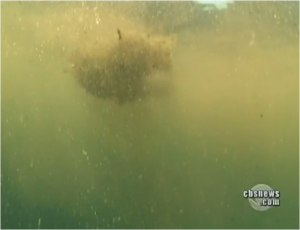This is the last post in a four part series discussing the ongoing – and “cascading” – effects in the Gulf, not from “oil,” but rather its toxic components and their impacts on sensitive ecosystems. Read the rest of the series.
 Once the more easily processed materials and their breakdown products have completed their complicated journeys through the Gulf ecosystems, that still leaves the toxins that don’t break down easily, both the polycyclic aromatic hydrocarbons (PAHs) and metals like arsenic that are associated with drilling accidents. By some estimates, as much as a quarter of the total volume of these toxins might end up back on the sea floor, and subjected to processing – and reprocessing – by sediment-eating “infaunal” invertebrates (worms and such), which are prey for bottom-feeding fishes and crustaceans. The same applies to marshes and beaches — foraging grounds for many sought-after fishes — as well as protected species, like migrating shorebirds.
Once the more easily processed materials and their breakdown products have completed their complicated journeys through the Gulf ecosystems, that still leaves the toxins that don’t break down easily, both the polycyclic aromatic hydrocarbons (PAHs) and metals like arsenic that are associated with drilling accidents. By some estimates, as much as a quarter of the total volume of these toxins might end up back on the sea floor, and subjected to processing – and reprocessing – by sediment-eating “infaunal” invertebrates (worms and such), which are prey for bottom-feeding fishes and crustaceans. The same applies to marshes and beaches — foraging grounds for many sought-after fishes — as well as protected species, like migrating shorebirds.

These relationships provide re-entry points for toxins back into food webs that sustain seafood production.
It could be many years before those chemicals wend their way – much more slowly, and through different pathways – through both the ecological systems of the Gulf and their human counterparts.
The pathways for many of these longer-lived toxins will also be altered as human uses resume. Shrimp trawling, for instance, will stir up sediments, potentially exacerbating the impacts of both toxicants and oxygen-demanding substances.
Again and in conclusion, some elements of the complex ecology of the Gulf of Mexico may well get off scot-free from the disaster. But many others will be heavily impaired, at least for some time. Taken together, there will be a significant total effect on the ecological systems and on the productivity and safety of seafood from the Gulf, significant human population impacts are expected, and those impacts must be remediated.













